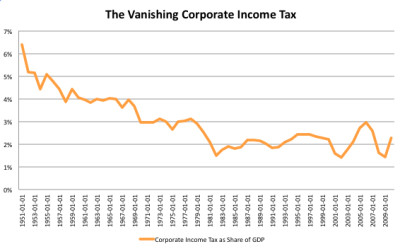
The Truth About U.S. vs. Foreign Corporate Tax Rates
Few things upset me more than the free pass many media outlets give to people who say things that are just not true. In many cases, these untruths often serve some larger purpose for their purveyors. Savvy CEO’s, for example, have often stampeded public agencies into decisions that fatten corporate coffers but are otherwise deeply unwise, in some cases, even catastrophic. And we all know how fear and dishonest arguments are used in Washington. Misguiding the public about real rates of corporate taxation, as Intel CEO Paul Otellini and California GOP U.S. Senate Candidate Carly Fiorina do in this article, is today’s case in point:
…”If our tax rate approached that of the rest of the world, corporations would have an incentive to invest here,” [Intel CEO Paul] Otellini said. But instead, it’s the second highest in the industrialized world, making the United States a less attractive place to invest — and create jobs — than places in Europe and Asia that are “clamoring” for Intel’s business. The comments from Intel’s chief executive echoed statements made a day earlier by Carly Fiorina, the former HP CEO turned Republican Senate candidate…”Our corporate tax rates are the second highest in the world,” and Congress has repeatedly failed to make an R&D tax credit permanent, Fiorina told the Aspen audience. It’s time to start “acknowledging the reality that companies go where they’re welcome,” she said. (The effective U.S. corporate income tax is 35 percent, far over the industrialized-nation average of 18.2 percent.)
And here is the truth (as if that matters anymore), from today’s New York Times:
The current corporate rate of 35 percent is higher than that in many other developed countries. But Congress has larded the code with so many deductions and loopholes — including a dollar-for-dollar credit for taxes paid to foreign governments and generous deductions for depreciation and debt financing — that the effective rate paid by most companies is below 22 percent, lower than in most developed countries.
So, what happens to Democracy when disinformation like this becomes the currency of the realm? Oh, how I wish more reporters would ask the tough questions required to reveal the unhuckstered truth.


